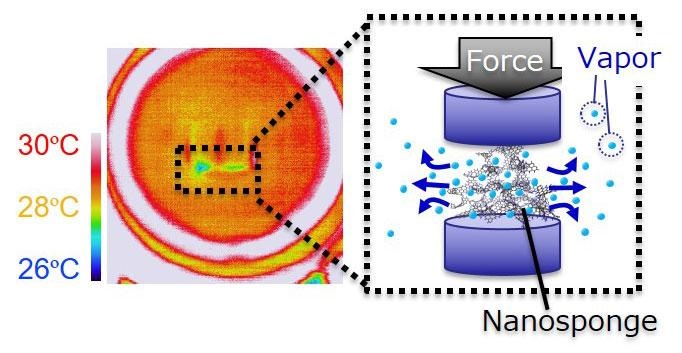Jun 20 2019
A group of researchers from Tohoku University, Nissan Motor Co., Shinshu University, and Okayama University has made a revolutionary discovery in the pursuit to substitute hydrofluorocarbons in refrigeration systems with natural refrigerants like alcohol and water.
 The cooling effect incused by sandwiched nanosponge. (Image credit: Hirotomo Nishihara)
The cooling effect incused by sandwiched nanosponge. (Image credit: Hirotomo Nishihara)
In their research, a liquid-to-gas phase transition was performed through a nanosponge, a soft, elastic material containing small nanopores less than 10 nm. The study outcomes could result in more efficient refrigerants with a relatively smaller carbon footprint.
Refrigeration systems are extensively employed in refrigerators and air conditioners. Traditional systems employ hydrofluorocarbons as a refrigerant. However, they are super pollutants. The Global Warming Potential of hydrofluorocarbons is around 1300 times greater than that of CO2.
The research group successfully performed a force-driven liquid-to-gas phase transition with the help of a nanosponge. On squeezing an ordinary, wet sponge, naturally, water is expected to ooze out. However, when a nanosponge with a pore size lesser than 10 nm is employed, a different phenomenon takes place. The sponge holds its liquid even under low pressure.
However, upon application of force, the oozed out liquid instantly evaporates into gas. Additionally, when the sponge retains its natural shape, it adsorbs the gas in the form of a liquid into the nanopores again.
To date, scientists have not performed the squeezing process of nanoporous materials since traditional materials are so tough that they cannot be deformed. However, the research group overcame this by developing their own soft, elastic, nanoporous materials, including a single layer of graphene walls. They quantified their outcomes with the help of a home-made equipment developed to examine liquid-gas phase transition upon application of mechanical force.
The group considered the squeezing technique after creating soft nanoporous materials. However, they never visualized their prediction turning into a reality in the first attempt.
So far, only two techniques have been available for transforming trapped liquid into gas. One method is heating and the other one is reducing the gas-phase pressure. The squeezing technique offers a third approach, creating a new idea in the field of physical chemistry and opening the door for more eco-friendly refrigeration systems.